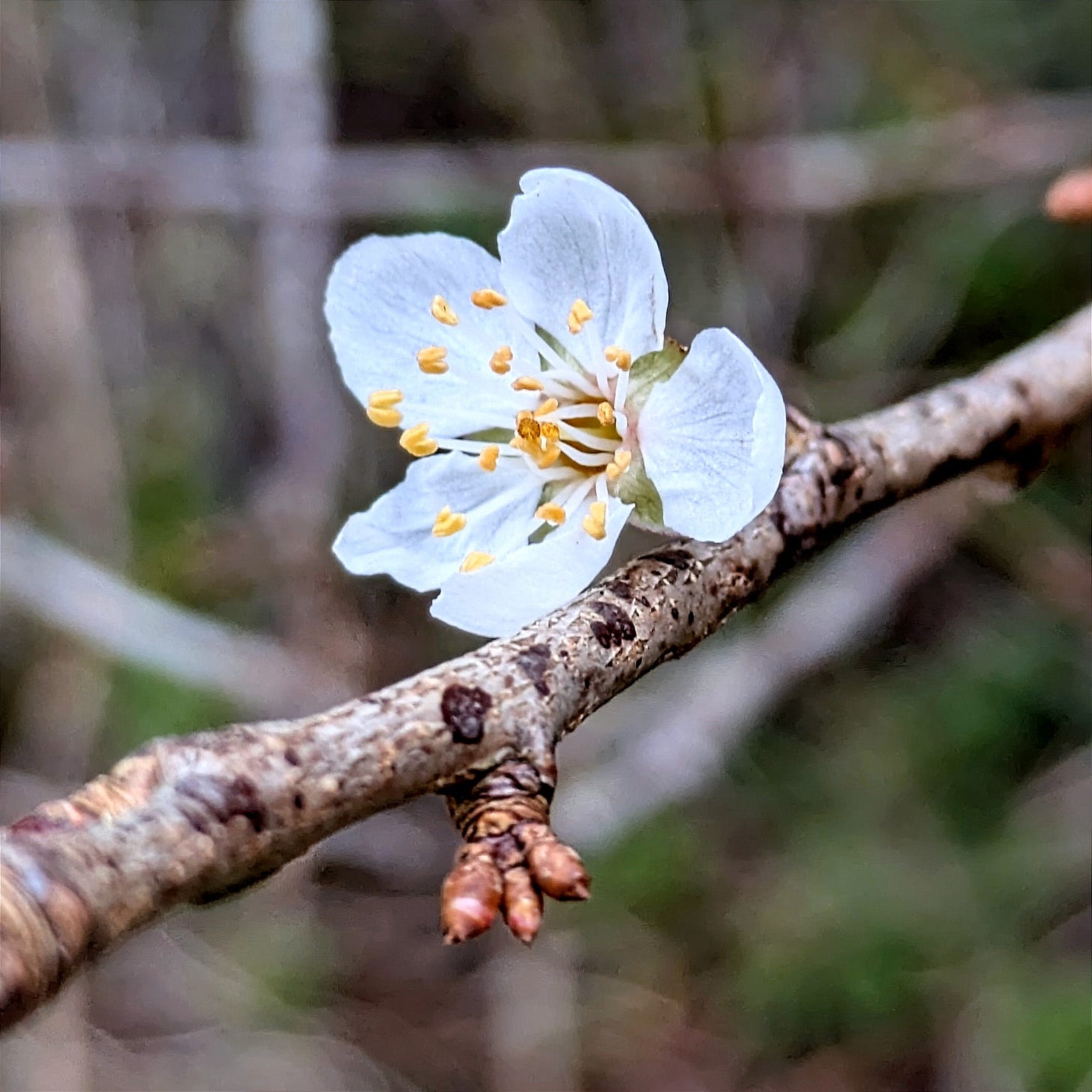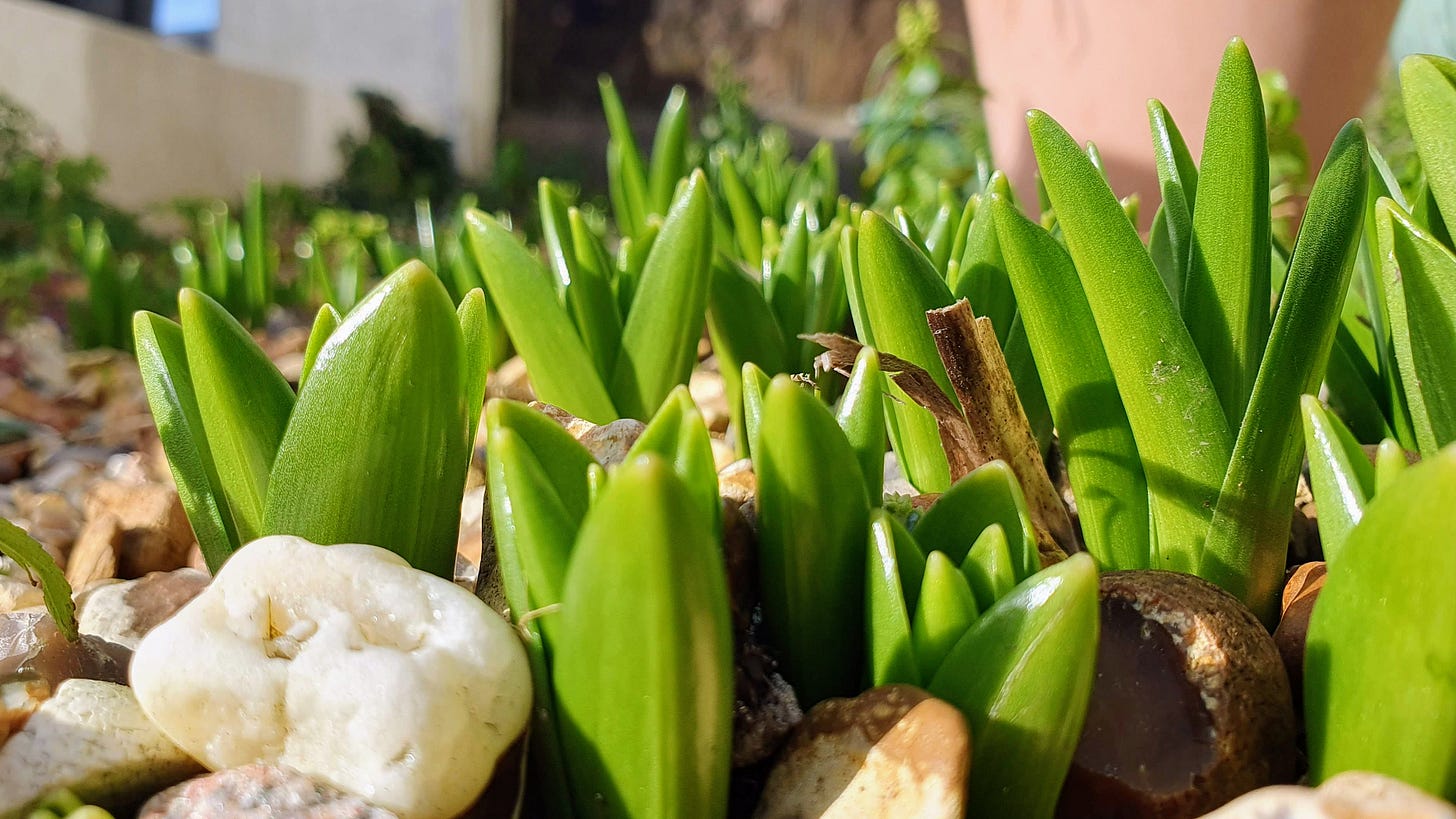Hello, I’m Rachel. I write about nature and creativity to encourage connection and wellbeing. This is one of my posts on how humans mark seasonal changes around the world. To read about other points in the year go to my homepage and click on the marking the seasons tab. To find out more about this publication go to this post. I’m in a flare-up of my chronic condition at the moment, so please excuse any typos and editing issues.
As I write this, both Bridget Dog and I are wrapped in our blankets on the sofa, socks and coats drying on the radiator. It was rather wet on our morning walk, but, enveloped in my coat, it didn’t really matter. It’s just rain. Drops of water bejewelled bare branches and made ripples in the puddles. The Sparrows’ morning hedge meeting sounded exceedingly boisterous. If only I spoke Sparrow.
But although it’s raining, although I’ve spent much of this month horizontal, that’s just January. It’s just one month of the year. I have needed to rest, many others have too and that’s ok. The rest of the world has kept going, either resting or preparing.
But, February is coming, Does it feel in some way momentous to you? Part of me thinks, it’s just another day, but the other thinks - yes! A new shiny start. Everything is going to be ok! That’s the part that flutters the butterflies in my tummy each time I remember that the ground is awakening, green shoots are pushing through, buds are unfurling and soon there will be colour.
I feel a bit disingenuous. So much of what I write about is singing the praises of the great outdoors and nature regardless of the time of year and weather. But today - January is a bit crap. I think it’s probably because I can’t get out as I would normally, even a stomp across the South Downs would help, so instead I am wishing the days away to spring.
Mother Nature did give me a little boost yesterday though, a hint of what is to come. A single blossom, shining out from the grey brown tangle of twigs, the rest of her friends still tight in their buds.
But - I promised you a celebration. Both astronomy, religion, and culture can help us here. 1st February is halfway between the Winter Solstice and the Spring Equinox, the wheel of the year continues to turn and the Gaelic festival of Imbolc celebrates this. It is also St Brigid’s Day, in honour of the Celtic Goddess adopted by the Irish Church to become their Patroness - they now even get a public holiday! St Brigid is the patron saint of healing and protection amongst other things, so I will be lighting a candle for her, hopefully she will grace me with her blessing.
Christianity marks this time with Candlemas on the 2nd February. In the Christian calendar, this day is in honour of Jesus being presented at the temple and the purification of Mary. It signifies the end of the 40 days of Christmas/Epiphany. But hmmm? Handily another reason to celebrate in the dark days of winter fitting with the seasons of the year marked for centuries.
My internet search for February festivals also showed that the 1st is National Freedom Day in the USA. Given recent events there, I hope it will still be honoured, there are certainly some that need to be reminded of the events that make up the USA’s history.
I would normally research and write more about the festivals to mark the seasons, but given the current state of my brain, unfortunately, I’m reaching my screen limit.
So instead - I’ll reach back into the archives. Below is one of my early posts, it’s strange to read it back, but it gives a bit more on how this point in the year was/can be celebrated and a window into what I was noticing then. Hopefully by the time the wheel has turned to the next festival, I’ll be well enough to tell you more about it.
A nudge from Nature
1st February 2023
Hello, here is my mid-week nudge from Nature. It’s a bit of a longer read today, my ponderings about our connection to the seasons, how it has been celebrated in history and what we could do today.
One of the ways I’m being more intentional in connecting with nature is by being more aware of the ways the seasons have been noted and celebrated as festivals. I know this may turn some people off, but stay with me. It does all ultimately come back to nature. I would like to suggest that we don’t have to view festivals such as Imbolc, which is today, as pagan, or against Christianity or indeed in any way religious if you don’t want to. The more I’ve read about the celebrations that form the wheel of the year, the more I see them as an opportunity for us to reconnect with nature and the seasons. Other than the weather, I know some city dwellers are almost entirely unaware of the changing seasons, even though there are still plenty of signs in our concrete world.
These festivals developed in ancient times as a way of marking the changing seasons and making sense of what was happening in the world before scientific advances explained them and the Christianity calendar took over. Many pre-Christian traditions and celebrations were subsumed by Christianity because people were celebrating anyway. As communities adopted Christianity, they continued using the same rituals, think of the bringing in of evergreens at Christmas and the use of light and fire. I am predominantly talking about Western/Christian countries here, though I know other cultures also have wonderful festivals and traditions associated with the seasons.
And so onto today. There are a host of pagan and Christian festivals around the 31st Jan-2nd Feb. Imbolc, the Spring Pagan Festival is celebrated on the 1st Feb in honour of the Goddess Brigid, which leads to St Brigid’s Day in Irish Christianity, (also the 1st Feb), celebrating St Brigid who may or may not have been a real 1st century Irish Nun. Candlemas (2nd Feb) in the Christian calendar, marks the end of the Christmas season when traditionally the holly and ivy were removed from houses to mark the beginning of Spring. Imagine that, Christmas continuing all the way through the dark short days rather than ending on Twelfth night. I’ve also just learnt that Groundhog day in North America has an association with Candlemas and of course, is when a groundhog decides if Spring is coming or not.
Whatever you call these days and whatever the origin, these festivals are ultimately celebrating the beginning of spring. It is halfway between the winter solstice and the spring equinox which are markers of day length and the position of the planet. The festivals are associated with the start of the lambing season (is there a more joyful spring sight than gambolling lambs?) and farmers preparing to plant their fields and restart the farming year. They focus on what many were doing at that point in the year.
For those of us without lambs to birth or fields to sow, or with no religious beliefs, it is still a time of anticipation. All talk seems to be about longer daylight, warmer weather and sightings of spring bulbs. On my social media timelines this morning there have been many posts celebrating getting through January, we need that hope that the long dark winter days are nearly over.
So, how does this help us connect with nature? I believe that just as we mark the year with religious festivals or secular holidays like birthdays, holding celebrations to notice nature makes an occasion of the moment. When we celebrate, we create memories around that date remembering what is happening in nature - often what the weather is doing. In the UK, we associate Christmas with snow, even though it rarely happens now. My childhood September birthday parties were nearly always outside wearing summer clothing, so in my world, summer lasts until then!
Traditional ways of celebrating the early Spring festivals include the making of St Brigid crosses from rushes, the lighting of fires and visiting Holy wells and water. Religious rituals at this time often centre around purification and cleansing, is this where spring cleaning comes from? Modern interpretations may be lighting candles or visiting a special body of water with friends and family. It’s a time of spring cleaning, I currently have the back door open, letting the fresh air in. We might grow spring bulbs and be planning which seeds we are going to grow this year. Or as I am doing, searching everywhere for green shoots peeking out, for buds on trees ready to burst and noting each new bird song I hear (more on this to come in my end-of-week letter). Another lovely suggestion I read about, linked to the ritual of purification and spring cleaning, would be to do a litter pick or beach clean, a very concrete way of helping nature. St Brigid is also the patron saint of craft, so I’ll take my sketchbook out later and do some green sketching.
So, however you want to describe it - happy Spring!
At the moment, everything I share and write here on Substack is free. But it takes time and energy to produce. If you’d like to drop me a donation via Ko-Fi, click on the link below. Thank you!
Until next time,













Lovely post Rachel. Wishing you all the best as we move into the longer days <3
Some lovely snowdrops spotted yesterday